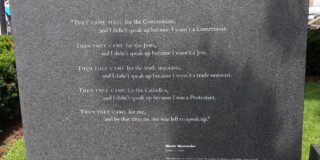Over the next few weeks I will be putting up posts written by those who have assisted me in collecting statements or who have introduced me to the victims of the human rights violations I have briefly outlined in the statistics included under the tab Racism in Australia – the facts. Prior to handing over the reins to others, I thought that I would take a detailed look at a serious case of racial hatred involving Ernst and Young, a major international consultancy firm with strong links to the public and private sectors in Australia.
Regular readers will recall that I have previously spoken about the case of the former Commissioner for ACT Revenue, a Wiradjuri Man, and the ongoing racial vilification he and his family have been subjected to by the ACT Government and the Australian Federal Police over a prolonged period.
The racism commenced in 2002 when Pat (not his real name) was appointed as Commissioner for ACT Revenue over the top of some longer serving ACT Treasury employees. Shortly after being overlooked for the Commissioner’s job, an ACT Treasury Official wrote to the Chief Executive of ACT Treasury requesting that Pat be sacked because he identifies as an Aborigine. A copy of the letter was forwarded to Pat by the Chief Executive on the same day. Following receipt of the latter, Pat made a complaint to Constable Mark Robert Coppen, AFP number 2735, at Civic Police station on 9 May, 2002. What happened about this complaint? Nothing. It was ignored by the AFP because it was made by a black Australian against a white Australian.
The racism experienced by Pat continued to simmer until March 2003, when Pat began making enquiries about monies that had been misappropriated, ‘stolen’ from ACT Treasury. Pat’s position on the issue of the stolen monies was that everyone, white and black, should be accountable to the same standards and that the ‘rule of law’ should apply equally regardless of race, creed or colour.
Corresponding to the signing of a Terms of Reference (ToR) for an enquiry into the stolen monies, the racial vilification of Pat increased to such an extent that in April 2003, Pat instructed Michael Long of Bradley Allen Lawyers to write to ACT Treasury putting them on notice that the he intended to pursue the racism through the appropriate channels if it was not dealt with in a professional manner.
The racial persecution of Pat reached such a stage that on 27th June 2003 he felt compelled to put the Chief Minister of the ACT on notice about what was going on within his public service. What happened with this complaint? Nothing. What’s worse is that the exchange of correspondence has mysteriously vanished from ACT Treasury; correspondence in which the Commissioner for ACT Revenue raised a number of serious concerns he had regarding corruption and racism within the ACT Government.
From this point on, the campaign of racial hatred against Pat increased until November 2003 when through his lawyers, Bradley Allen, Pat put the Chief Executive of ACT Treasury on notice that he intended to commence an action for defamation against the most profligate of the racists attacking him.
A few days after the Chief Executive received notification from Pat’s lawyers advising him that Pat proposed to commence an action for defamation. The officer Pat identified as the ‘ring-leader’ of the racists then contacted two of Pat’s previous employers, the ANZ Bank and Ernst & Young. While the ANZ Bank raised questions about the legality of the request and referred the matter back to the Commissioner for ACT Revenue, Ernst & Young, in the person of Tanya Taylor, invited the writer in and apparently discussed all aspects of Pat’s application with Ernst & Young with the writer, including bringing out documents from Pat’s personnel file.
Following the writers meeting with Tanya Taylor he formally wrote to Ernst & Young requesting documents from Pat’s personnel file. Incomprehensibly Ernst & Young provided the writer with the documents requested.
There are a number of significant issues here. Firstly, Mrs Tu Pham, the then Deputy Chief Executive of ACT Treasury and current ACT Auditor-General, testified in proceedings in March 2006 that the writer of the letter to Ernst & Young was not authorised to conduct an investigation into his superior or to use ACT Government stationary to gain access to documents he would not otherwise have had access to. Secondly, Ernst & Young could not have legally provided the documents under NPP 10(d) as this provision is specifically for law enforcement agencies and ACT Treasury is not a law enforcement agency for the purposes of the the National Privacy Principles (NPP). Thirdly, the documents provided by Ernst & Young pursuant to the request are not the same documents that Pat provided to Ernst & Young when they approached him and offered him a job.
When the AFP eventually gained access to Pat’s personnel file from Ernst & Young and tendered it into evidence in support of charges they had brought against Pat, what they tendered into evidence were documents that did not contain Pat’s signature or any other biometric data linking those documents to him. There was a signature that purported to be Pat’s, but which matched no other signatures of his on his Ernst & Young or ACT Treasury personnel files.
It is incomprehensible that someone can walk in off the street, ask Ernst & Young for the personnel file of their boss, who was incidentally conducting a fraud investigation into them and gain access to it. What Ernst & Young achieved in providing documentation under the apparent request from ACT Treasury was to end the investigation being conducted by the Commissioner for ACT Revenue into a subordinate officer for fraud and stop an application being made to HREOC, alleging that the writer of that request and a former Director of Ernst & Young had committed acts of racial hatred against the former Commissioner for ACT Revenue.
ACT Treasury and the Australian Federal Police would like to pretend that this is all made up. However, the former Commissioner for ACT Revenue, because of the extent of the racial vilification and racial hatred he was being subjected to from within ACT Treasury, due to him wanting to hold those in power accountable for their actions, sought help from a Registered Psychologist, Dr Jillian Fleming. Dr Fleming has provided a letter (page 1 & page 2) to Pat’s former lawyers, which clearly states that Pat was discussing the racial hatred and defamation he was being subjected to from within the ACT Government with her for a number of months in the lead up to his dismissal.
What is most telling about this case is that ACT Treasury can make official correspondence disappear and refuse to comply with a subpoena and face no penalty, because the victim is an Aborigine. Likewise, Ernst & Young can just handover documents from a previous employee’s personnel file to a subordinate in another workplace and suffer no penalty. Why? Because the victim is an Aboriginal Australian, which goes to prove that a black man, no matter how hard he works, will never be the equal of a white in the eyes of white society.
Aftermath
On 3rd July 2006 Pat raised all of these issues with ACT Treasury. On 24 July, 2006 Mr Graeme Dowell, the current Commissioner for ACT Revenue, responded to Pat advising him that the matters were referred to the Australian Federal Police.
What became of this referral? Nothing. Neither Pat nor anyone else who could have provided evidence about the issues raised were contacted by the Australian Federal Police. The Commonwealth Ombudsman and the Commonwealth Privacy Commissioner have both closed the complaints made about the conduct of both Ernst & Young and ACT Treasury, with no action taken. The AFP subsequently advised Pat that the author of the request to Ernst & Young had not committed fraud, even though he received an advantage in bringing legal actions and fraud investigations against him to an end. He hasn’t committed fraud, even though ACT Treasury has stated that he was not authorised to use ACT Government stationary to seek private and confidential information on his superior from a third party, a superior who was investigating him for fraud on the basis of a complaint made by a member of the public, Mr Wylucki. If it wasn’t fraud, then what was it?
It just goes to show that the Commonwealth Ombudsman, the Commonwealth Privacy Commissioner and the Australian Federal Police have one rule for white Australians and a totally different one for black Australians.
If this isn’t racism, then what is?



Why hasn’t anyone been charged over what is a blatant case of racial hatred. Is there still such a thing as a criminal conspiracy in the ACT? If so, surly what Ernst & Young did with ACT Treasury would pass the threshold for a charge to be brought by the AFP against both parties. Sorry forgot the victim is black and the conspirators white – no charges there.
There comes a time in life, when you walk away from all the drama and the people who create it. You surround yourself with people who make you laugh, forget the bad, and focus on the good. So, love the people who treat you right. Forget about the ones who don’t. Life is too short to be anything but happy. Falling down is part of LIFE … Getting back up is LIVING.
Its time to return to the living and for the ones who have been really bad for a long time and have committed crimes to cover it up are dealt with finally. This is the year that everyone who has been mistreated racially villivied returns to the living.
Hi Phil thanks for your comments. Yes, after about five years of research and racial vilification from the Australian Federal Police and the ACT Government things are starting to come together. The UN Human Rights Committee is aware of what all those Indigenous Australians who have provided me with statements have to say. It’s now just a matter of timing. Cheers Bakchos.